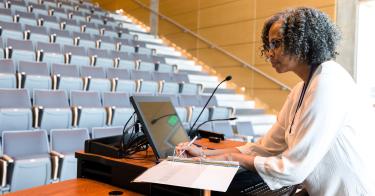“Most Americans in most of the country can now go mask free,” President Biden declared in the State of the Union Address. But at a Harvard seminar held on the same day, the speaker was masked and largely unintelligible apart from the slides that fortunately accompanied the verbiage. The masked audience was invisible and mostly inaudible to those attending the seminar online.
Despite presidential encouragement and new advice from the Centers for Disease Control and Prevention (CDC) on mask-wearing mandates, Ivy League and other high-prestige colleges and universities across the country are only slowly lowering the educational barriers that have turned undergraduates into dull, emotionally disturbed lambs by limiting their social contacts, restricting their access to dining halls, and, worst of all, denying them in-person instruction throughout the 2020-21 academic year and beyond.
Last year’s data are now in. Over half the colleges and universities across the country denied students full access to in-person learning even while other young people were attending lectures, enlivening basketball arenas, and filling football stadiums. Last spring, 524 colleges and universities allowed students to learn inside the classroom. But 589 other institutions told students they must take their courses online, while another 293 offered a combination of in-person and online learning opportunities.
The consequences for students were serious.
>>> Kansas Weighs Protecting Rights of Children, Families in Education
Undergraduate enrollment dropped by 7.8 percent from their levels in fall 2019, driven by a 13.3 percent decrease in freshmen enrollment. Many enrolled students asked for tuition reductions and refunds on the grounds they are “not getting the same education online.”
Student demands are not ill-founded. An abundance of research from before and during the pandemic shows that virtual instruction is inferior to in-person learning. A West Point study shows that students forced to take classes online did not enjoy classes as much as classmates lucky enough to win the lottery and go to class. They also performed at dramatically lower levels on the final exam. On other campuses, virtual learning led to declines in course completions, course grades and exam scores. Meanwhile, campus suicide rates and mental health traumas are on the rise.
Variation in COVID spread does not explain the wide variation in college closures across the country. According to research by the College Crisis Initiative, there was in 2020-21 no discernible difference in COVID-19 case rates in communities where universities were open for in-person instruction and places where colleges asked students to take classes online.
If COVID was not enough to force campus closures, what was driving so many universities not to serve students in person? The College Crisis Initiative study suggests that status and prestige had adverse effects. Other things equal, those universities with larger endowments and higher tuition prices were more likely to restrict in-person access. Schools with more selective admission policies were more likely to bar students from campus.
Universities were also highly responsive to political pressure—or else their leaders simply shared the political convictions of state officials in their area. Students in states with Democratic governors and legislatures were much more likely to be attending class virtually compared to those in states with Republican control of state governments—even after controlling for admission selectivity, tuition price and community COVID-19 case rates.
Surprisingly, sports are good for education. Those universities with an NCAA football program were more likely to offer in-person instruction. Perhaps the alumnae insisted that the football season remain intact, or perhaps college sports create communities that administrators cannot easily disturb.
>>> Offering Hope to Oklahoma Students, Families
But financial concerns may be the driving force. High-prestige, well-endowed institutions can survive a very bad year, but others simply cannot. It is perhaps for this reason that private 4-year baccalaureate colleges were more likely to offer classes in-person than were state universities. Many small, liberal-arts colleges have limited enrollments, minimal endowments and few research grants. Because they are more financially precarious and tend to be more reliant on tuition revenue, they are more responsive to their students’ needs.
Ironically, the more prestigious the institution, the less likely it was to live up to its central mission of educating young people. Less selective institutions that need to maintain revenue flow were more likely to be open for business. Universities with more research funding and bigger endowments could signal their virtue and maintain their political connections at the expense of the education and mental well-being of their students.
This is unfortunate for students and society alike. Many students struggled over the past two years and didn’t get the college experience they expected. And the country may not get the educated citizenry they pay well over $200 billion for each year in federal tax dollars alone.
This piece originally appeared in the Hill on 03/21/2022





